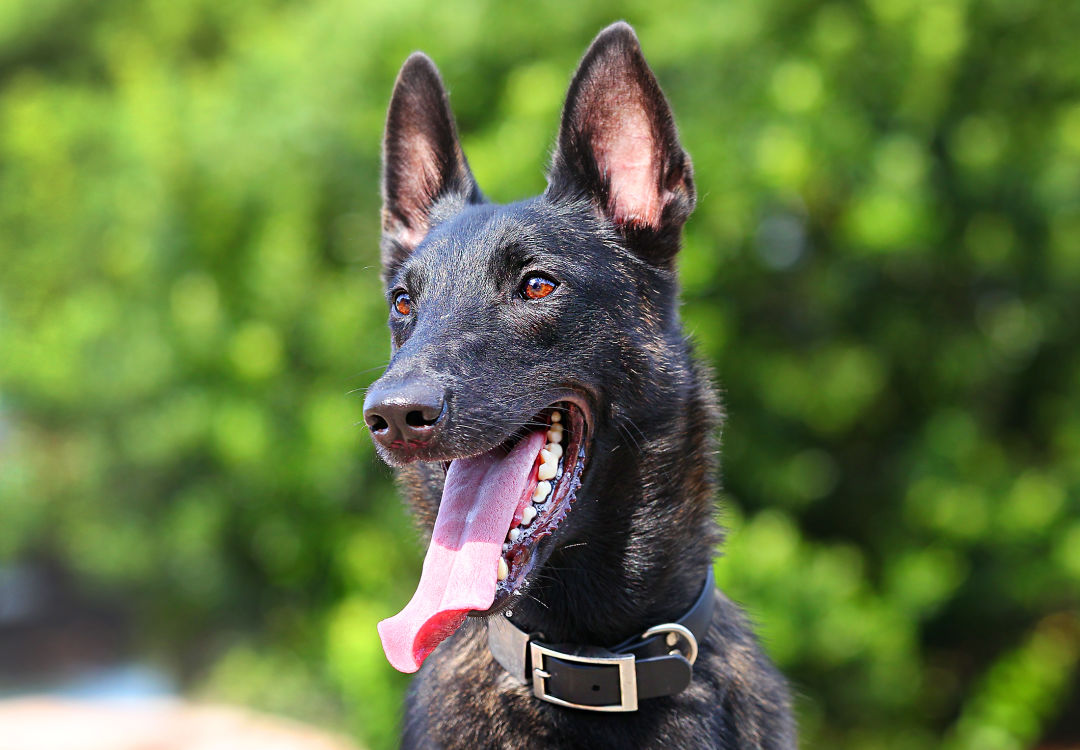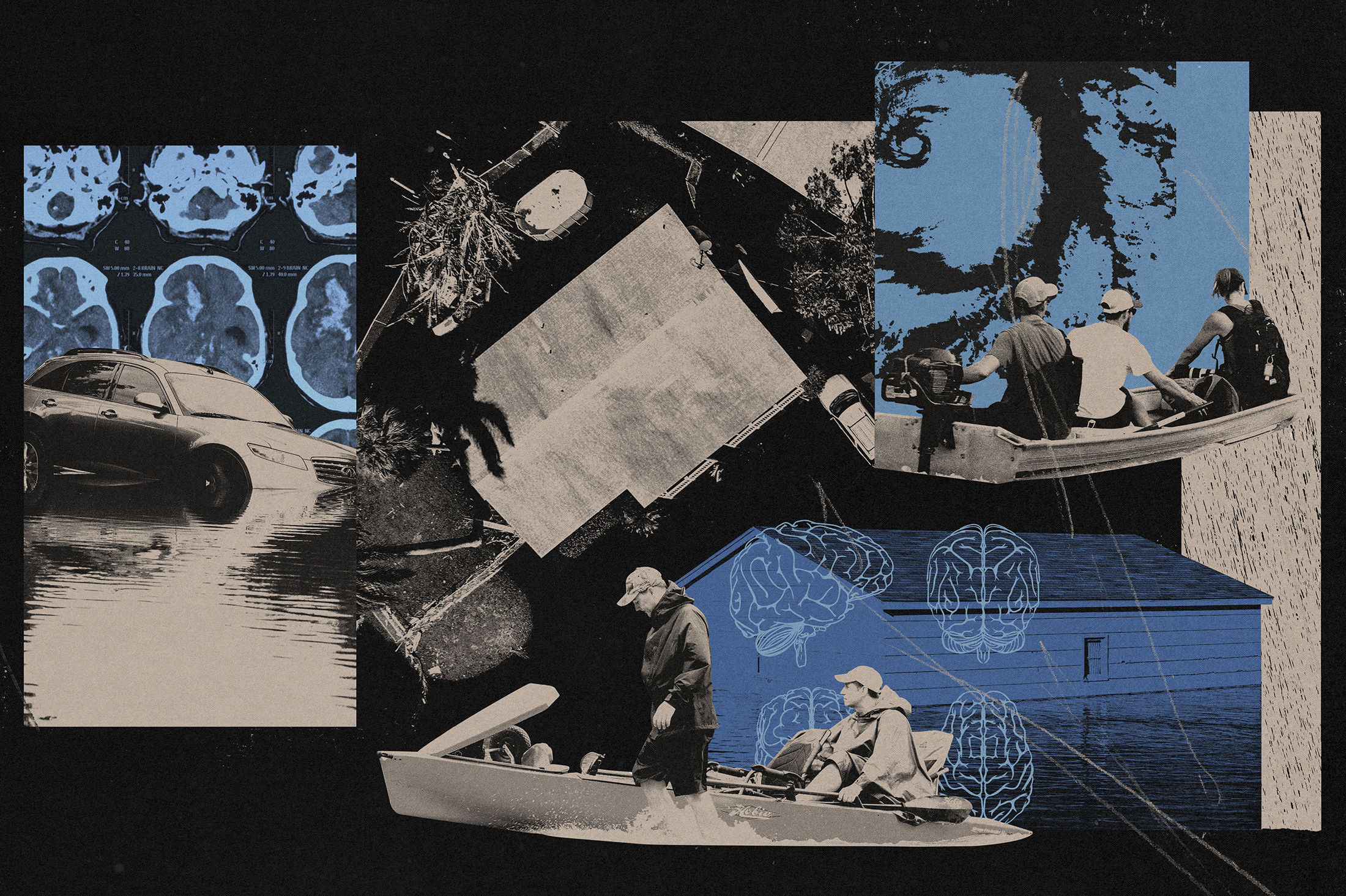How Texas Human Remains–Detecting Dogs Help Find the Missing

A half-eaten rat lies in the grass of the Lorraine Cherry Nature Preserve in The Heights. Missing a head and forelimbs, its pink-gray entrails catch the light of the morning sun and glisten with a viscid, wet shine. But Kerrigan doesn’t pay the corpse any mind, resisting her instincts to roll around in the rot and luxuriate in the stink. She’s a consummate professional with one task in mind: find the hidden human remains.
OK, put the popcorn down for a sec there, true crime aficionados.
Nobody went missing in the park, much less died under mysterious circumstances, and there’s no case to solve. Kerrigan is a 4-year-old Dutch shepherd working as a human remains detection dog—known less formally as “cadaver dogs” or “corpse-sniffing dogs”—and she’s showing off her skills for a demonstration presented by K-9 Search and Rescue of Texas (K-9 SAR TX). But Kerrigan didn’t realize she’d end up as a working dog at first. Her handler, Kristin Cardenas, adopted her from Harris County Pets when she was only a little over a year old. Six months later, she completed the training needed to become a fully fledged human remains detection dog. Kerrigan now serves on K-9 SAR TX’s search and rescue team, a commitment that has lasted for around three years so far.
“I fostered her for a month, and I was like, ‘This dog is terrible. She can't go back.’ So, I ended up keeping her, obviously,” Cardenas says. “You have to really change your life to fit this dog.”
Unlike her other dogs, who don’t complain about a little R&R, Kerrigan prefers keeping busy. In addition to her work as a human remains detection dog, she herds goats; competes in dock diving, flyball, and wall-climbing championships (and often wins); and runs on a treadmill with a weighted vest. Staying in shape is integral to her work in helping find missing persons, and she’s at her happiest when she’s been given a task to accomplish.
For the demonstration, Cardenas gives Kerrigan a command to search. In response, the devoted dog sniffs the environment with single-minded focus to find the missing human. When or if a body—alive or dead—has been found, Kerrigan is trained to sit quietly until her handler catches up. Then, she’ll nose her way through the brush to show the bits of blood or bone that she’s discovered; humans take over the investigation from there.
They are not playing a grim game of fetch out of the Addams Family here. Possessing human remains is legal in Texas, and search and rescue canine organizations obtain them through education-oriented channels. It’s considered an essential resource for saving lives and, when that's not possible, for finding bodies to give families closure. Search and rescue, like the work Kerrigan, Cardenas, and K-9 SAR TX training coordinator Mary Jane Boyd do, requires deep concentration and extensive training. Not every dog has what it takes: “They've got to be confident. They've got to be athletic. They have to have the ability to focus through distractions,” Boyd says. “If those aren't present, they're not going to work.” Dogs must also have “nerve strength” and both prey and hunting drives, she adds.
Testing the abilities of potential search and rescue and human-remains dogs involves more playtime than the actual mission training. To get an idea of a candidate’s prey and hunt drives, a toy gets tossed into some brush for the dog to find. On the second round, the dog is spun around to delay fetch time by 30 seconds. The trainers do a few more rounds, pushing the time between releasing the toy and allowing the dog to find it by longer intervals each time until there’s about a minute lapse. Finding the toy within two to four minutes is ideal. “Even if they don't find it, I don't want them to quit. You can't have a dog that quits,” Boyd says.
In Texas, Dutch shepherds like Kerrigan, Labrador retrievers, and Belgian Malinois—“working, sporting breeds,” Boyd calls them—make for some of the most popular search and rescue dogs. However, mutts with the right temperaments and builds can also do the job. Most smaller breeds can’t navigate certain terrains with tall grass and eye-level thorns and brambles. Boyd once had a pug who possessed the drive to work in search and rescue or human remains detection, but lacked the height. He never deployed on a real case, but he sometimes showed off at demonstrations to entertain onlookers.
K-9 SAR TX provides training and education to private citizens and other search and rescue organizations, and also certifies dogs that meet the rigorous criteria needed to best serve the public, but it’s rare. As evaluators for the National Association for Search and Rescue, Boyd has certified only four dogs since the organization opened 25 years ago, and Cardenas—who has been with K-9 SAR TX for 15 years—has cleared three. It also takes ongoing dedication, as each dog’s license must be renewed every two years. “These are not pets,” Boyd says, adding that many people praise their dog’s ability to find toys in their backyard and believe this to be all it takes to succeed in a rescue scenario. “I'm like, ‘OK, how many people get lost in your backyard?” Most dogs simply aren’t suitable—a truth that frustrates many owners. “It's more about them and the dog than about the job,” Boyd says. “It has to be about the job.”
Because so much of the work K-9 SAR TX and similar organizations take part in is confidential due to their close relationship with law enforcement, myths about what is required of these dogs and their handlers spread easily. Boyd says “wannabees” often bring their pets to searches, but without certification, which can compromise safety. A good boy or girl doesn’t necessarily translate into a good worker.
For one, different assignments require different skill sets, and even the most stalwart canines can’t perform their jobs effectively without proper training. Disaster dogs serve in dangerous, high-pressure environments, such as hurricanes and the aftermath of bombings. Live find-area-search dogs look for survivors, and human remains–detecting dogs primarily focus on finding people, both dead and alive. These can involve adults with dementia who have wandered off, missing children, kidnapping victims, and others who disappear. Given the sensitive, and sometimes classified, nature of their work and the need for family privacy, Boyd and Cardenas don’t discuss many details of their cases. But the more they work—Boyd believes she’s gone on about 100 jobs with K-9 SAR TX—the keener their own human skills become.

Image: Courtesy of Kristin Cardenas
“I think if you've done this long enough, you’re probably almost as good as the dog,” Cardenas says. Still, they bring the dogs for accuracy’s sake. There are some things a person’s nose can’t detect, even if they smell the same odors as their four-legged partners. “It's a matter of them being able to pinpoint where that source is coming from, because you'll get scent pools where it's going to collect,” she adds. Going through this training allows them to develop “scent pictures,” which refers to the way in which canines interpret a target odor in relation to its surrounding environment. “The longer something's been out, the harder it is to pinpoint because the scent spreads.”
Humans, too, need training just as much as their canine counterparts. According to Boyd, an effective search and rescue handler takes courses on confined-space and water awareness; they must know the basics of CPR and first aid for both dogs and humans, plus effective radio communications and how to navigate to provide coordinates within at least a 10-percent margin of error using only a compass. Search and rescue dogs can only be deployed effectively when their handlers know where to go. In a city as massive as Houston, not having a starting point can result in a significant waste of resources, however much rescuers wish to help, and could lead to a handler compromising an active crime scene. “We get a lot of calls from families, and they're hysterical because somebody's gone missing. They'll tell you anything to get you to come out, which is why we won't go until we are contacted,” Boyd says.
Most missions won’t unearth much of anything. The victories instead lie in trying in the first place, narrowing down the possibilities to find the missing person, rather than a single “Eureka!” moment.
Regardless of how a story turns out, the job takes an emotional toll on the human halves of the teams. Cardenas and Boyd have discovered the victims of serial killers and encountered inhumane body disposals. “I think the kids are the most difficult…or the people we can't find. That's what gets me the most,” says Boyd, adding that she must compartmentalize to avoid becoming overwhelmed by the inherent grimness and feelings of fear, anxiety, grief, and anger that permeate their profession.
Fortunately, not every assignment proves so bleak. K-9 SAR TX assisted with the restoration of the Conroe Community Cemetery, a historically Black graveyard with headstones dating back to the 1890s. After the cemetery renovation was complete, the dogs helped point out bodies in unmarked graves that needed a memorial. Considering most of them were interred without modern embalming methods or chemicals, the remains were much easier to find. In February, the cemetery received official recognition by the Texas Historical Commission as a Texas Historical Cemetery. It’s a project that Cardenas is particularly proud of. They’ve since done a few more cemetery restorations, which they consider a welcome change of pace. “It's great, because we feel like we're doing something worthwhile,” Boyd says.
The emotional stakes are also much lower. “Everybody knows these people are dead,” she says. “There's no expectation that there's a miracle waiting.”




